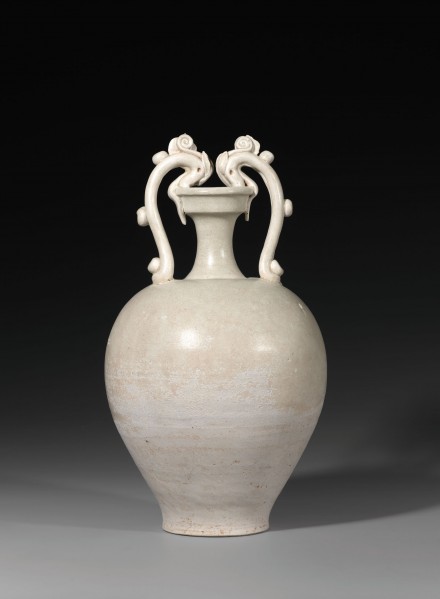J.J. Lally & Co., Oriental Art / New York City, New York
MenuPast Exhibition
EARLY CHINESE WHITE WARES
The Ronald W. Longsdorf Collection
September 11 - October 3, 2015

12.
AN AMPHORA WITH DRAGON HANDLES
Tang Dynasty, A.D. 7th Century
Xing or Gongxian kilns
the ovoid vessel surmounted by a slender neck flanked by studded double-stranded handles rising from the high shoulders and ending in stylized horned dragon heads biting at the rounded rim of the wide cup-shaped mouth, covered with a very finely crackled translucent glaze of pale greenish tint ending in an uneven line below the median, the sides tapered down to a solid base with slightly splayed edge, the exposed white stoneware showing pinkish coloration from firing.
Height 13 1⁄8 inches (33.3 cm)
This amphora is published by Liu, A Survey of Chinese Ceramics, Vol. 1, Early Wares: Prehistoric to Tenth Century, Taipei, 1991, p. 224.
A very similar glazed white stoneware amphora with dragon handles discovered in a Tang dynasty tomb at the construction site of Xi’an Textile Factory Hospital, now in the Xi’an Institute of Cultural Relics Preservation is illustrated by Zhang (ed.) in Zhongguo chutu ciqi quanji (Complete Collection of Ceramic Art Unearthed in China), Vol. 15: Shaanxi, Beijing, 2008, p. 69, no. 69, described as “made in the Xing kilns in Hebei,” but the author also notes that some scholars regard the vase as a product of the Gongyi (formerly called Gongxian) kilns in Henan province.
Other glazed white amphora vases of very similar form are in the Meiyintang Collection, illustrated by Krahl, Chinese Ceramics from the Meiyintang Collection, Volume One, London, 1994, p. 137, no. 224; in the Musée Guimet, Paris, illustrated by Paul-David, et. al., The World’s Great Collections: Oriental Ceramics, Vol. 7: Musée Guimet, Paris, Tokyo, 1975, no. 21; and in the Turner Collection, now in the Columbia Museum of Art, illustrated in Eye to the East: The Turner Collection of Chinese Art, Columbia, 2008, p. 31.
唐 邢窰或鞏縣窰白瓷雙龍耳瓶 高 33.3 厘米
12.
AN AMPHORA WITH DRAGON HANDLES
Tang Dynasty, A.D. 7th Century
Xing or Gongxian kilns
Height 13 1⁄8 inches (33.3 cm)